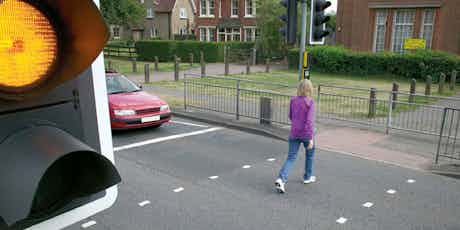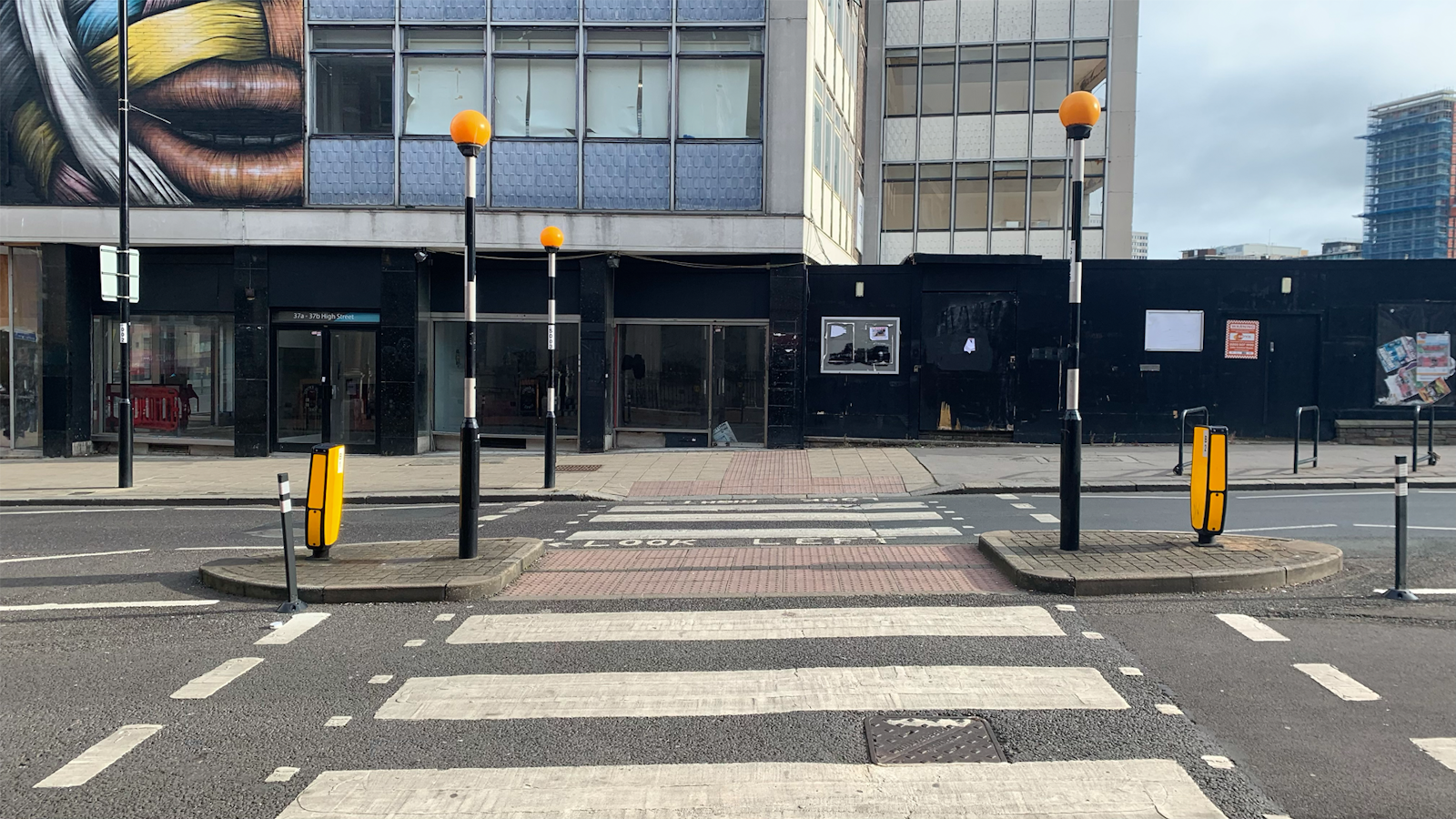Types of pedestrian crossings in the UK
May 13, 2022 by Graham King

Toucan. Puffin. Pelican. Zebra. No, not a random list of exotic birds and a stripy horse, but some of the types of pedestrian crossing you will come across on UK roads. But what exactly are these crossings and how should drivers interact with them?
This guide will walk you through all the different types of pedestrian crossing you’ll find in the UK, and how to deal with them.
Zebra crossings

This is perhaps the most well-known type of crossing in the UK. As the name suggests, a zebra crossing is marked with black and white stripes on the road. Flashing yellow lights on top of black and white poles signal the crossing to approaching drivers.
Rules for drivers
If a pedestrian is waiting to, or looks like they wish to use a zebra crossing, drivers must give way to them. When you see a zebra crossing, always drive at an appropriate speed which would allow you time to stop if a pedestrian were to use the crossing.
Rules for pedestrians
Pedestrians have right of way over drivers and cyclists when using a zebra crossing. That said, always stop and look both ways for drivers who may be distracted.
Pelican crossings

Pelican crossings are controlled by traffic lights. Pedestrians press a button to request a crossing and wait for the green person to indicate that they can cross. Simultaneously, the traffic lights will turn to red, signalling approaching traffic to stop.
Rules for drivers
When a pedestrian pushes the button on a pelican crossing, the traffic lights for cars will turn red meaning you must stop. When the light flashes amber, you can only continue if there are no pedestrians on the crossing or wishing to use the crossing.
Rules for pedestrians
If you wish to use a pelican crossing, you must push the button and wait for the green person to illuminate. If a red person is showing, you must not step into the road.
Puffin crossings
Puffin crossings are fundamentally the same as Pelican crossings, except they use ‘intelligent’ signals. A Pelican crossing cycle works according to set timings; Puffin crossings use sensors to determine when the crossing is clear. Thus, if one person crosses quickly, traffic will only be stationary briefly. If lots of pedestrians cross slowly, traffic will be stationary longer.
Many local councils in the UK are replacing existing Pelican crossings with Puffin crossings to improve traffic flow, especially in places prone to queues.
Rules for drivers
The rules on a Puffin crossing are the same as those on a Pelican crossing, so you must stop when the traffic lights turn red. Once the amber light is flashing, you may proceed if there are no pedestrians on the crossing.
Rules for pedestrians
As with Pelican crossings, pedestrians wanting to use a Puffin crossing have to push the button and wait for the green person to light up.
Toucan crossings

Toucan crossings are incorporated into cycle routes. As such, they allow cyclists to cross without dismounting, as they should at other crossings. They are controlled by Pelican- or Puffin-type signals and drivers should treat them as they would any other signal-controlled crossing.
Toucan crossings are also incorporated into many signal-controlled road junctions, usually crossroads. A green cycle signal shows before the main green light, giving cyclists some time to get ahead of any vehicles. This reduces the risk of cyclists colliding with vehicles. A relatively recent development, this type of crossing is becoming more common and will likely become a standard feature of all major road junctions.
Rules for drivers
Again, Toucan crossings are traffic light controlled, so a red light means stop and a flashing amber light means you must give way to pedestrians.
Rules for pedestrians
If you want to cross at a Toucan crossing, you push the button and wait for the green person and bike to light up. If you’re on a bike, the highway code says that you must do your best to look out for pedestrians, so be careful when cycling close to people.
School warden crossings
These are the domain of the iconic lollipop person. At times when schools open and close, a warden will be stationed on the road outside the school to control traffic, allowing pedestrians to cross the road. They stand at the side of the road wearing a hi-vis jacket and holding a stop sign at the end of a long red and white striped pole. Be prepared to stop if you see one.
The warden will usually indicate to approaching traffic that they intend to enter the road, or else just step out. When this happens, drivers must stop, leaving plenty of space for pedestrians. They can only move on once the warden has cleared the road.
Rules for drivers
If the lollipop person indicates that they would like to step out, drivers should give way to them. They will then hold traffic until the pedestrians have crossed the road.
Rules for pedestrians
If you wish to cross the road at a school warden crossing, you should wait until the lollipop person has stopped traffic before stepping into the road.
Equestrian crossings

This is a signal-controlled crossing specifically for horses. They are quite rare and most likely to be seen in rural areas, after a ‘horses crossing’ road sign. Drivers should treat them as they would any other signal-controlled crossing. And, of course, not do anything that might startle horses on or near the crossing. The button to activate the traffic lights is high up on a pole a few metres from the lights so riders don’t have to get off their horse to press.
Rules for drivers
Equestrian crossings are traffic light controlled, so drivers must stop when the traffic lights turn red. You should also take extra care around horses not to make too much noise which may startle the animals. So no pressing the horn or revving the engine.
Rules for pedestrians
Horse riders who want to use an equestrian crossing should push the button and wait for the green light to show.
Pedestrian crossings FAQs
What do I do if the crossing has a central island?
Central islands occur on all the types of crossing detailed above. Such crossings are, in effect, two separate crossings. At such crossings with signals, drivers and pedestrians must obey the signals. It is worth noting that, if pedestrians are crossing the on-coming lane, it is likely that the signals are about to change and drivers approaching should be prepared to stop.
At such crossings without signals, drivers should stop for pedestrians waiting to cross their lane. They do not have to stop for pedestrians waiting to cross the opposite lane. But be aware that a pedestrian on the opposite side may try to run across without stopping on the island, as they should.
Can I park at a crossing?
White, zig-zag lines run along the side and down the middle of the road for a distance either side of any pedestrian crossing. Drivers cannot park in those areas unless there is an emergency. Even outside those areas, it is prudent not to park near a crossing if doing so would create an obstruction that would impact the safety of the crossing.
Can I signal to pedestrians that they can cross the road?
At a crossing, simply stopping is sufficient indication that pedestrians can cross. Stopping to allow pedestrians to cross where there is no marked crossing, or at a signal-controlled crossing showing a green light to traffic, impedes traffic flow, which the Highway Code prohibits.
Signalling to a pedestrian that they can cross the road can also cause confusion. The pedestrian may assume that, because you’ve signalled to them, that it’s safe to cross, even if there are cars or cyclists coming. It’s safest to not signal to pedestrians.
Do pedestrian crossings have cameras?
Zebra crossings don’t have cameras because they’re not traffic light controlled. Any crossing which is traffic light controlled may have a safety camera which will ticket you for jumping the red light.
Remember
At any type of crossing, it is ultimately up to the pedestrian when they cross. A driver may think it is safe, but they might not. So be patient.
Equally, be patient when pedestrians are crossing. Elderly and disabled people might have difficulty walking, and anyone with young children will know how hard it can be to get them to move quickly. Drivers should never try to hurry pedestrians up and only move on once the crossing is completely clear. Of course, it can be frustrating when someone takes an age to cross the road. But drivers have a duty to be patient as cars are dangerous things that can easily kill a pedestrian.
As in all aspects of driving, obeying the Highway Code around crossings will ensure that you do not get into trouble and avoid any fines/points/prison time that would result from not doing so.
Cars Change? Carwow!
Looking for a new set of wheels? With Carwow you can sell your car quickly and for a fair price – as well as find great offers on your next one. Whether you’re looking to buy a car brand new, are after something used or you want to explore car leasing options, Carwow is your one stop shop for new car deals.















